
Description of the attraction
The Basilica of San Domenico, also called the Basilica of Catherine, is one of the most important and most revered churches in Siena. Its construction was carried out in 1226-1265, but in the 14th century the building was significantly modified, and acquired its current Gothic appearance. This large church, like many other mendicant churches, is built of brick and has a magnificent bell tower on the left. The latter was somewhat reduced in size after the 1798 earthquake. The interior decoration of the basilica is very unusual - it is made in the form of an Egyptian cross with a huge central nave, covered with farms, and a transept with magnificent chapels. The church houses several relics that belonged to Saint Catherine of Siena, and her house is located nearby.
Particularly noteworthy is the Chapel of the Chapel delle Volte - an ancient place of prayer for Dominican monks, associated with numerous episodes from the life of St. Catherine. Here you can see the painting Canonization of Saint Catherine, painted by Mattia Preti and framed on both sides by works by Crescenzio Gambarelli from the 17th century. A portrait of the saint hangs on the central wall - it is believed that this is the only reliable image of her in the world.
No less interesting are the paintings that adorn the walls of the nave, among which one can name "Madonna and Child" by Francesco di Vannuccio, "Eternity" by Il Sodom and a predella with 15 scenes from the New Testament by Antonio Magagna. The altars on the right side are decorated with works by Stefano Volpi and Alessandro Casolani, there is also the ark of St. Catherine. Nearby there is a chapel, in the center of which the head of the saint and her thumb are kept in the altar. The marble floor of the chapel depicting Orpheus and various animals is attributed to Francesco di Giorgio. In the crypt, open to the public, you can see the crucifixion of Sano di Pietro.






